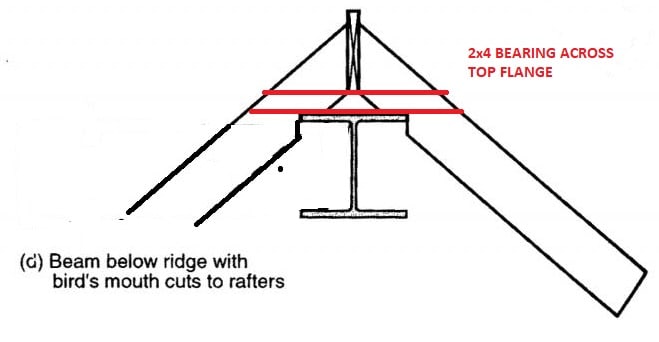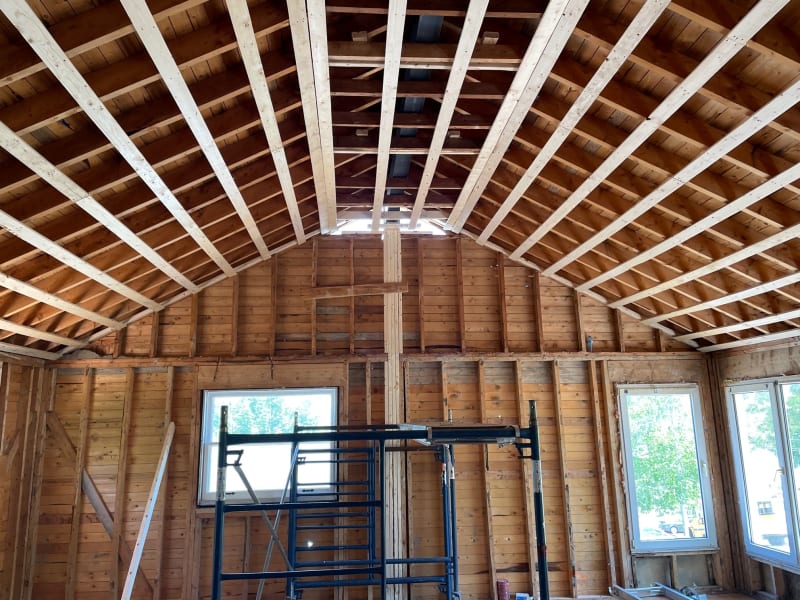Hi Folks - A client has installed a ridge beam, then called the engineer. The rafters were not bird mouthed to transfer the reaction of the rafter vertically. It cannot be done now so as a alternate, proposing to use a 2x4 tie running along the full top flange to get vertical bearing all the way across. As-is, the rafters are only bearing on the end of the flange and the beam may not be serving its intended purpose.
Navigation
Install the app
How to install the app on iOS
Follow along with the video below to see how to install our site as a web app on your home screen.
Note: This feature may not be available in some browsers.
More options
Style variation
-
Congratulations MintJulep on being selected by the Eng-Tips community for having the most helpful posts in the forums last week. Way to Go!
You are using an out of date browser. It may not display this or other websites correctly.
You should upgrade or use an alternative browser.
You should upgrade or use an alternative browser.
BEARING ON TOP OF A STEEL RIDGE BEAM 3
- Thread starter Ian 2017
- Start date
- Status
- Not open for further replies.
- Thread starter
- #2
- Thread starter
- #3
-
1
- #4
- Thread starter
- #5
- Thread starter
- #6
- Thread starter
- #7
-
2
- #8
milkshakelake
Structural
I suggest a nailing pattern with 8d nails like this:

You can calculate it, which would mean calculating the shear in the nails. I wouldn't worry about the bending or shear on the 2x4 too much. Maybe use 2x6 to get more nails in. If you overdesign it like in the nailing pattern I showed, you should be fine. Roughly, without going into any NDS calculations or Cd factors, each 8d nail can carry about 100 lb. If the span of joist is 24" x 15' plus 15 psf DL and 30 psf LL, you'll get a shear of 675 lb (2'x15'/2 times 45 psf). Using 8 8d nails at 100 lb shear capacity each, it's 800 lb > 675 lb.
The other concern is uplift. Do you have something to tie down the joists?

You can calculate it, which would mean calculating the shear in the nails. I wouldn't worry about the bending or shear on the 2x4 too much. Maybe use 2x6 to get more nails in. If you overdesign it like in the nailing pattern I showed, you should be fine. Roughly, without going into any NDS calculations or Cd factors, each 8d nail can carry about 100 lb. If the span of joist is 24" x 15' plus 15 psf DL and 30 psf LL, you'll get a shear of 675 lb (2'x15'/2 times 45 psf). Using 8 8d nails at 100 lb shear capacity each, it's 800 lb > 675 lb.
The other concern is uplift. Do you have something to tie down the joists?
MIStructE_IRE
Structural
I’m half tempted to think that the knife edge contact between timber and steel will locally crush until the bearing area becomes sufficient to prevent further crushing, thus finding its own new state of equilibrium and doesn’t go any further. I’d love to see what would happen... but it will no doubt crack the ceiling!
I think your idea is probably all you can do at this stage. I’d also strap it back down around the beam to resist uplift.
I think your idea is probably all you can do at this stage. I’d also strap it back down around the beam to resist uplift.
- Thread starter
- #11
Thanks to all! Great team effort. milkshakelake nailing pattern makes sense. MIS StructE IRE, now that you say this, yes, I have seen this before making the steel beam useless. And phamENG, I do have the collar ties remaining as the installers used them to slide the 21' beam through the gable end of the house so that takes care of the uplift concerns.
Related to this, the owner is spray foaming with closed cell insulation. All of the suppliers websites promote this as adding structural strength. I never give this consideration in the calcs but it does make sense. Curious if anyone has ever seen a technical analysis of this?
Related to this, the owner is spray foaming with closed cell insulation. All of the suppliers websites promote this as adding structural strength. I never give this consideration in the calcs but it does make sense. Curious if anyone has ever seen a technical analysis of this?
Ian 2017 said:so that takes care of the uplift concerns
Make sure it's shimmed tight. If they were able to slide it in, then whatever slop they needed to allow it to move is now between the collar ties and the ridge, not the ridge and the rafters.
Sounds like a cute marketing gimmick. Does it? Maybe. Has it been proven the level necessary to assign a predictable and reliable strength for use in engineering applications? I seriously doubt it. I'd be happy for somebody to prove me wrong, of course. Two things to consider - 1) what kind of strength? flexure? in-plane shear/lateral/diaphragm? 2) in whatever way it's supposed to help, is it stiffer than what's already there? If the answer to number 2 is no, then it doesn't really matter. It won't be engaged until the normal system has deflected or deformed well past its serviceability limit.Ian 2017 said:All of the suppliers websites promote this as adding structural strength.
- Status
- Not open for further replies.
Similar threads
- Replies
- 11
- Views
- 1K
- Question
- Replies
- 20
- Views
- 7K
- Question
- Replies
- 9
- Views
- 8K
- Replies
- 2
- Views
- 2K
- Question
- Replies
- 3
- Views
- 753


